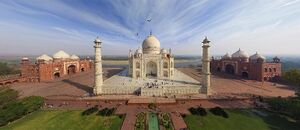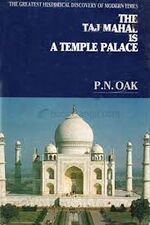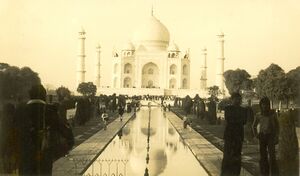Taj Mahal
The Taj Mahal (ताज महल) is an ivory-white marble mausoleum on the south bank of the Yamuna river in Agra. It is stated in tourist literature that it was commissioned in 1632 by the Mughal emperor Shah Jahan (reigned 1628–1658), to house the tomb of his favourite wife, Mumtaz Mahal. The tomb is the centrepiece of a 17-hectare (42-acre) complex, which includes a mosque and a guest house, and is set in formal gardens on three sides. It is said that Taj Mahal was built from Makrana marble.
World Heritage site
The Taj Mahal was designated as a UNESCO World Heritage Site in 1983. Described by Nobel laureate Rabindranath Tagore as "the tear-drop on the cheek of time", it is regarded by many as the best example of Mughal architecture and a symbol of India's rich history. The Taj Mahal attracts 7-8 million visitors a year.
The controversy about Taj Mahal
Some historians have challenged the story about Taj Mahal being propagated as having been built by Shah Jahan. In his book Taj Mahal: The True Story, historian P.N. Oak claims that the Taj Mahal was originally a Shiva temple named Tejo Mahalaya seized by Shah Jahan and adopted as a tomb. He says that Mahal is a word to describe a royal palace and not a tomb and after seizure by Shah Jahan, the name was changed to Taj Mahal. These historians opine that Taj Mahal is one of the old buildings occupied forcibly by Muslim rulers; and that, after giving a different external shape and Arabian/Persian inscriptions installed on the walls, forced the writers of history to propagate that those buildings and castles were built by those Muslim rulers.
Taj Mahal: a Tejaji temple
Main article: Tajmahal is a Hindu Temple Palace
There are large number of Tejaji temples in India in the states of Rajasthan, Gujarat, Madhya Prdesh, Uttar Pradesh and Haryana. The book, Taj Mahal: The True Story (ISBN 0-9611614-4-2), written by Purushottam Nagesh Oak or P. N. Oak, the founder-president of the Institute for Rewriting Indian History. The book seeks to prove that the Taj Mahal was originally a Hindu temple whose existence predated the Mughal Empire. The people who dominate the Agra region are Jats. Shiva bears thousand names. There are two names based on Teja (Tejo in Rajasthani) in this list, namely: Tejomayadyutidhara, Tejonidhi. Jats know Shiva by the name Tejaji. The Jat special issue of The Illustrated Weekly of India (June 28, 1971) mentions that the Jats have the Teja Mandirs, i.e., Teja Temples. This is because Teja-Linga is among the several names of the Shiva Lingas. From this it is apparent that the Taj-Mahal is Tejo-Mahalaya, The Great Abode of Tejaji.[1]
The following points are among the pieces of evidence presented:
- Carbon dating of samples taken from the doorway of the Taj Mahal from the side of the Jamuna rivers revealed that the door was 300 years older than the period of Shah Jahan. The carbon dating was arranged by Marvin Miller, an economist in New York.
- Johan Albert Mandelso, a European traveller who visited Agra in 1638, seven years after the death of Mumtaz Mahal, vividly described the life of the city in his memoirs, but makes no reference to Taj Mahal or any large construction activity going on to build it.
- Peter Mundy, an Englishman, visited Agra within a year of Mumtaz’s death. From his writings, it appears that the Taj Mahal was already a noteworthy building well before Shah Jahan came to power.
Also see
Tajmahal is a Hindu Temple Palace
External Links
- Official website of Taj Mahal - Uttar Pradesh Government
- Taj Mahal is an ancient Shiva Temple - book can be downloaded in PDF format
- P.N. Oak's Hindi book archives
- The True Story of Taj Mahal, book by P.N. Oak - Read on-line and save in PDF format
Dndeswal (talk) 04:11, 7 March 2017 (EST)


